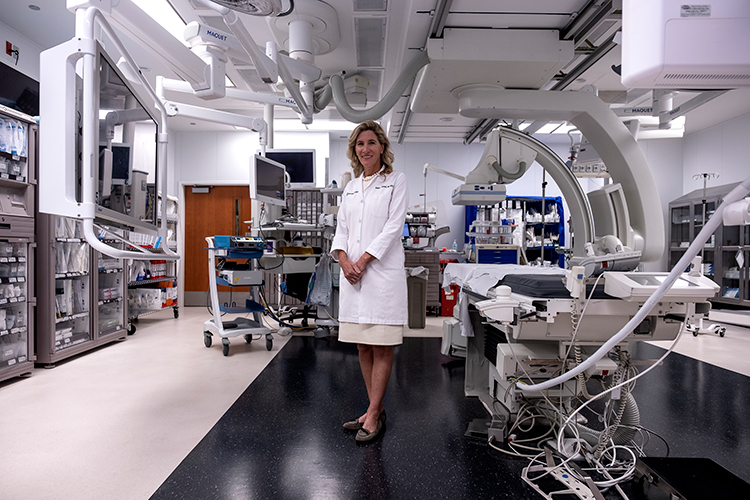
The next worst thing to finding out you have breast cancer is the reality that you’ll have to have to endure weeks of radiation therapy after your lumpectomy.
The traditional radiation treatment used to be Monday through Friday for six weeks, or about 30 treatments. In recent years, the trend has been to shorten it to Monday through Friday for only three weeks, or about 16 treatments.
Now, if you meet certain criteria, the newest form of treatment is one-dose targeted intraoperative radiation therapy (IORT) which is completed at the same time as your lumpectomy surgery and eliminates the need for any further radiation visits.
“Targeted intraoperative radiation therapy is a course of radiation that’s given as one dose at the same time as the surgery, right after the lumpectomy is performed,” said Dr. Anastasia Tousimis of Cleveland Clinic Indian River Hospital. “This type of radiation is for select women with breast cancer who are undergoing breast conservation therapy, which entails removing the tumor (lumpectomy) and checking the lymph node under the armpit (sentinel node biopsy). After that procedure is performed, the patient receives approximately 20 minutes of IORT at the lumpectomy site.
“Perhaps the biggest patient advantage of IORT is the time-saving factor,” Dr. Tousimis continued. “They come into the hospital in the morning and go home that afternoon. The next day they can do everything they normally do but they can’t do any heavy lifting or straining, swimming or driving if they are taking any pain pills. A week later they are back to all their normal activities.”
What differentiates IORT from traditional radiation therapy (external beam radiotherapy, or EBRT) is that it delivers radiation directly to the tumor or tumor bed instead of treating the entire breast. All of the radiation can be delivered at one time versus the standard radiation schedule of five days a week for up to six weeks. And because it is so targeted, the dosage of radiation is much smaller, thereby preserving nearby healthy organ and tissues.
“The whole theory behind this type of radiation is that when a woman has a reoccurrence of breast cancer after a lumpectomy and radiation therapy, 90 percent occur at the lumpectomy site, which is considered the area of highest risk,” Dr. Tousimis explained. “Instead of treating the entire breast, we target the area has the highest risk of reoccurrence.
“It’s important to note that we follow national guidelines and only select certain patients for this type of treatment. The patient has to be older than 50, have a tumor less than 2 centimeters in size and be diagnosed with invasive ductal cancer, which is the most common type of breast cancer.
They also have to have hormone positive tumors, meaning their tumors are estrogen positive and lymph node negative. Plus, their lumpectomy specimen has to have clear margins.”
For those patients who qualify, IORT is completed in one day. Under general anesthesia the surgeon will remove the tumor and then place a radiation applicator directly into the tumor bed, where it emits radiation 1 centimeter deep into the lumpectomy cavity. The device delivers a smaller dose of X-rays than in standard radiation therapy. Your radiation team will determine the proper dose of radiation, and after about 20 to 30 minutes of radiation the incision is closed.
The technology was developed by a surgeon in the 1990s and the Europeans have been using this type of radiation for years. A randomized study published in the Lancet medical journal in 2010 compared 2,000 women. Half of them got targeted radiation and half of them got the traditional six weeks of whole breast radiation. The study showed that local recurrence rates were similar in the two groups. A more recent publication in the August 2022 Radiation Oncology Journal showed that the intraoperative group actually had a better non-breast cancer survival rate than the other group, most likely due to sparing the heart and lungs from radiation.
Because IORT requires unique equipment that may not be available at every healthcare facility, it is used less often than external beam radiotherapy. Fortunately, Cleveland Clinic Indian River Hospital has the equipment and accredited surgeons.
Of course, early diagnosis is the best way to achieve a cure for breast cancer. The American Cancer Society recommends annual mammogram screening starting at the age of 40 for women at average risk for breast cancer. A woman is considered average risk if she doesn’t have a personal history of breast cancer, a strong family history of breast cancer, or a genetic mutation known to increase the risk of breast cancer (such as a BRCA gene), and has not had chest radiation therapy before the age of 30.
Women who are a high risk for breast cancer should get a breast MRI and a mammogram every year starting at 30. High-risk women have a lifetime risk of breast cancer 20 percent to 25 percent greater than women at average risk, based on family history. Lifetime risk is 80 percent higher for those who have the BRCA gene mutation based on genetic testing, or have a first-degree relative with the BRCA gene but have not had genetic testing themselves.
“If a patient has a strong family history of breast cancer, we recommend starting their screening 10 years younger than your first-degree relative’s diagnosis,” Dr. Tousimis advised. “That means if your mother was diagnosed at age 45, you should start screening at 35. We also encourage regular exercise and a healthy, low-fat Mediterranean diet.”
Dr. Tousimis completed her medical education at Albany Medical College and her residency at Guthrie Clinic. She finished her fellowship at Memorial Sloan Kettering Cancer Center specializing in Breast Oncology Surgery, followed by an MBA at the Massachusetts Institute of Technology. Her office is located in the Scully-Welsh Cancer Center, 3555 10th Court, Vero Beach. Call 772-770-6856 to schedule an appointment.



